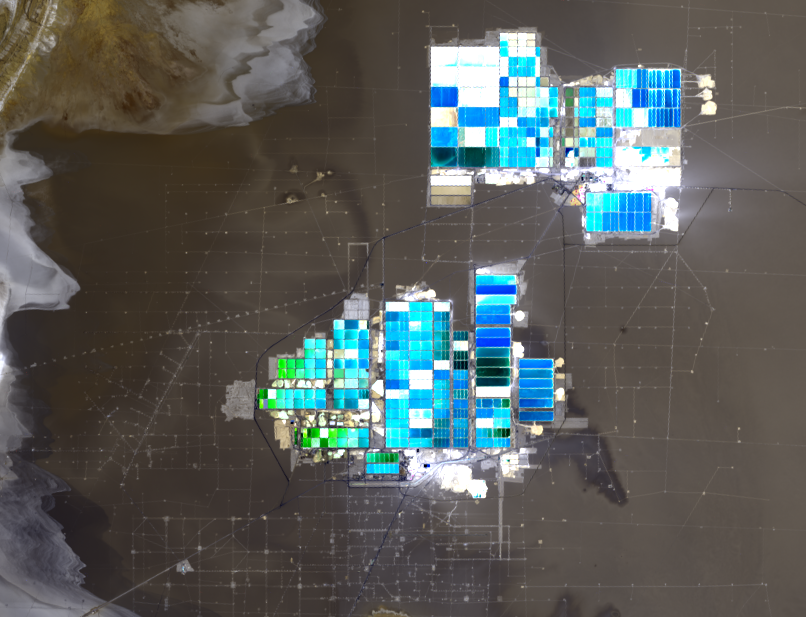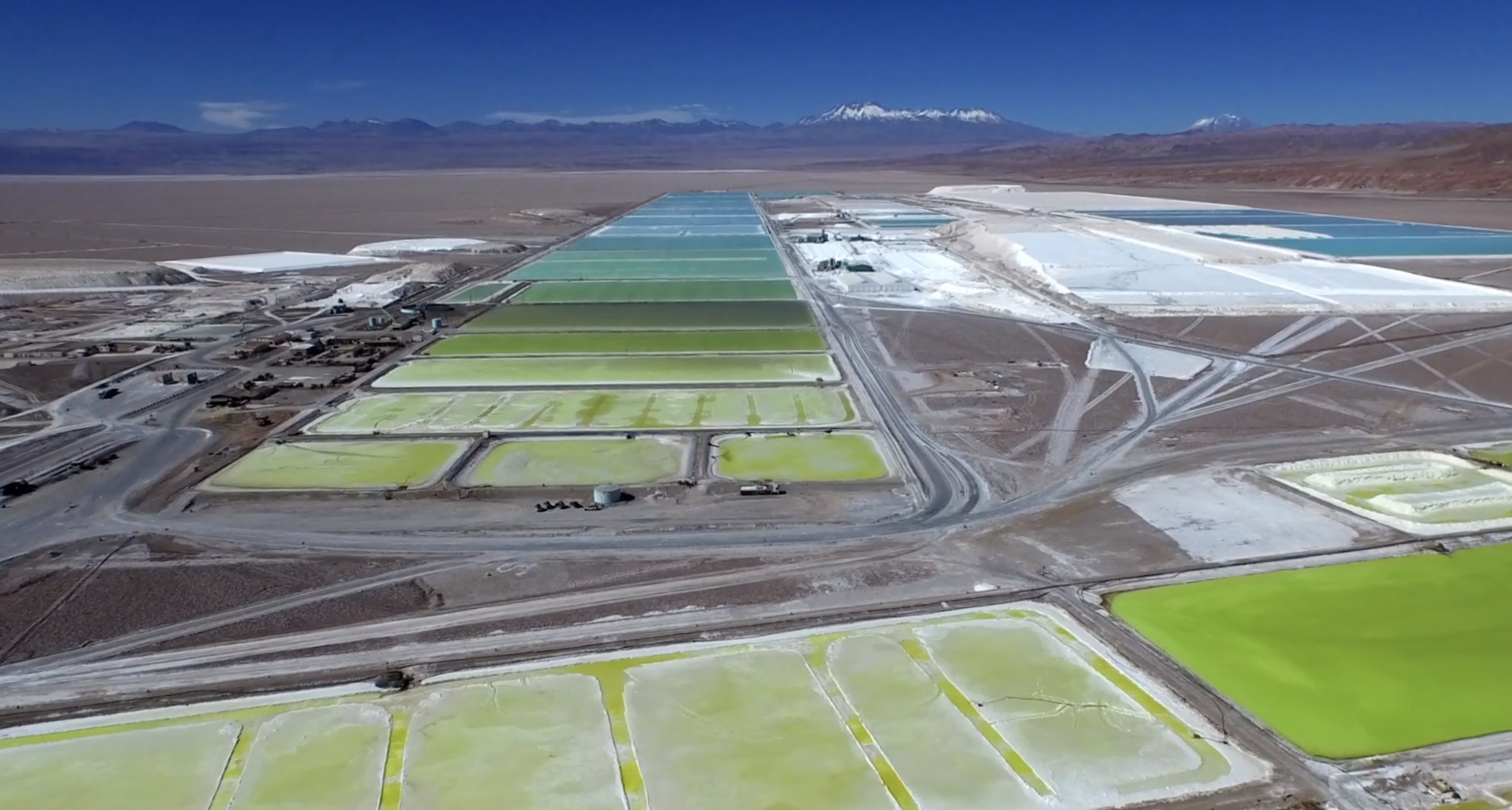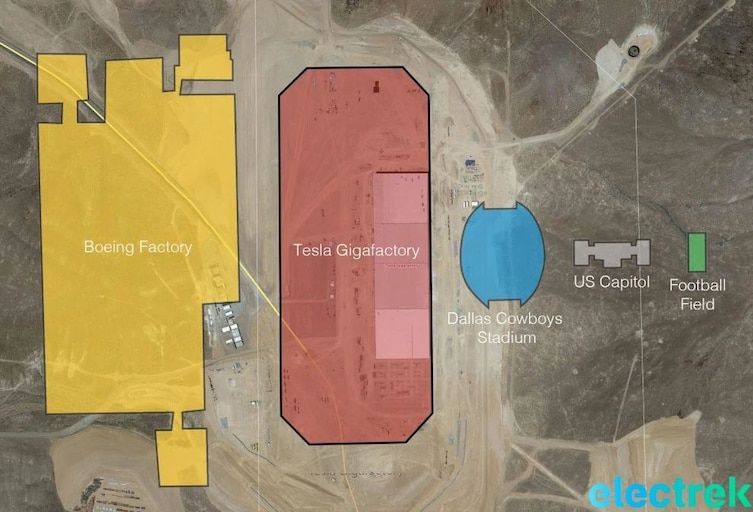Lithium Landscapes: From Abstract Imaginaries to Deep Time and Multi-Scalar Topologies
 Friday, May 21, 2021 at 4:40PM
Friday, May 21, 2021 at 4:40PM Samir Bhowmik
[ PDF Version ]
I. Lithium Imaginaries

Figure 1. Satellite image of the Salar de Atacama. (Source and copyright: USGS)
From space, the lithium fields of the Salar de Atacama in Chile appear like a multi-colored mosaic or plots of agricultural lands arranged in grids.[1] To some, they might even appear as ancient hieroglyphs or giant technological objects like touchscreens and iPads. On the ground, the landscapes of lithium appear as rows upon rows of conical white hills, fantastical arrays of vibrant fields set against the backdrop of an endless horizon. It looks like an arctic landscape, filled with snow, depicting a purity, making the fields seemingly at one with nature. Here, the future stretches out into infinity.
Zoom out from Salar into the Nevada desert and you might spot Tesla’s Gigafactory, designed to resemble the batteries manufactured there. The size of several football fields, the facility is large enough to accommodate a complete Boeing Factory.[2] In the harsh desert landscape, it looks strangely out of place, like an unwieldy and ugly spaceship that has crash-landed, having run through its fuel supplies.

Figure 2. Left, artist rendering of Gigafactory Nevada (Image copyrights: Tesla); right, artist rendering of Gigafactory in Finland (Image source & copyrights: YLE)
This whimsical image of a battery megastructure also appears in Northern Finland. The promotional campaign of a failed bid for a Gigafactory shows the stylized rendering of a 18650 Lithium-ion cell carpeted with solar panels, with windmills in the surrounding landscape.[3] The image hypothesizes an age of energy sufficiency. The battery-like form of the Gigafactory promises the existence and continuation of verdant landscapes. Yet, the megastructure has no relations to the landscape in which it is set, and which it will eventually exploit. The positive-negative terminals and the cylindrical body of the lithium-ion battery has no functional correspondence with the factory's architecture. In other words, its form factor has nothing to do with the building, nor its utopian context.[4] It is but a technical diagram super-imposed on the landscape. This immediately recalls the image of the Salar de Atacama with its endless orthogonal grid of lithium fields, where the landscape is subjected to the technical processes of extraction.
These two scenes of the field and factory are examples of the sort of imaginaries this essay briefly explores in order to better understand the visual cultures and environmental costs of lithium-based energy systems. The imaginaries and other visualizations that I analyze here challenge us to re-examine the relationship between representation and the actual extent of lithium extraction, manufacturing, and waste. In this article, I argue that to understand the environmental implications of lithium, we also need to examine its representations that allow us deeper insights into its topologies, its deep time, and its multi-scalar aspects.
II. Lithium Dreams and Hieroglyphs
The visual imagery of lithium can be gathered from a plethora of short documentaries, movies, and online news clips. Years ago, the Lithium Dreams project, led by Kate Davies and Liam Young of the Unknown Fields Division, turned a mundane field study trip into an exciting new media adventure that “explor[ed] the infrastructure behind the scenes of our electric future.”[5] This is a perfect example of what media theorist Shannon Mattern describes as “extreme field work.”[6] The project examined lithium extraction zones in Bolivia and the Salar de Atacama, resulting in drone imagery, an artwork of a battery “fashioned from glass, graphite, aluminum, nickel and lithium brine collected from the Salar De Uyuni in Bolivia,” a trailer for a Japanese racing car, and a short film about a daily commute consumed with the digital. These projects present a rich and varied view of lithium mining. They suggest an approach that blends visual artistry with hands-on field study.

Drone image from the Lithium Dreams project by Unknown Fields Division, 2015 (Image source and copyrights: Unknown Fields Division)
Although Lithium Dreams employs diverse forms and genres of mediation from sculpture to drone and film, it does not quite visualize the multi-scalarity and extended temporalities of lithium energy production and consumption. Documentaries such as Lithium Revolution (dir. Andreas Pichler and Julio Weiss, 2012) or The Dark Side of Green Energy (dir. Jean-Louis Pérez and Guillaume Pitron, 2020) also do not present a comprehensive cycle of the lithium battery production, focusing solely on the extraction zone. No doubt, the visual imagery of the lithium fields is striking, but the neglect of the other aspects such as manufacturing, shipping, and e-waste is noticeable. Lithium mines are certainly worth examining. But merely surveying extraction sites while ignoring the other processes by which lithium is made available for smartphones or EMVs makes any fieldwork or film of an extraction zone incomplete.
For decades the battery has been a symbol of cheap and portable energy, as visualized in the endless drumming of the Duracell and the Energizer Bunnies. Introduced to TV audiences in 1973 and 1989, respectively, both expound the energy of their consumer products. The bunnies continue to promote lithium-ion batteries even today. Other television commercials and print advertisements depict the battery as renewable, harmless, and recyclable. Citing Marx, Sean Cubitt asserts that the lithium-ion battery is a social hieroglyphic, “an ostensibly innocent artifact in which is disguised a world of complex networks which, however, present themselves to humans in ‘the form of a movement made by things, and these things, far from being under their control, in fact control them.’”[7]

Figure 4. Lithium Fields by Mafalda Paiva. (Image copyrights belong to Mafalda Paiva)
While mainstream imagery of lithium batteries has usually obfuscated the global networks of energy products, the artistic depiction of the extraction zone takes us to back to a fictional scenario. Portuguese artist Mafalda Paiva's painting Lithium Fields, which depicts the Atacama Desert reminds us of what could have been—a paradise instead of an extractive landscape.[8] In the artist’s vision, “the salt flats hum with a preternatural vibrancy, an effect produced by the exaggerated density of species and radically foreshortened topography.”[9] In what could be the Garden of Eden, the landscape looks verdant and untouched. It teems with flamingos, ducks, llamas, and other animals, which gather around the water bodies at the base of the foothills. It is a scene radically opposed to the vast extraction zone of the lithium fields, as depicted in the satellite images of the USGS, which reduce the landscape to an abstraction on a planetary scale. The painting is more immediate and intimate, reminding us of the region’s environment and biodiversity.
Finally, consider the artist renderings of the various Tesla Gigafactories that have been promoted as enticing images of energy sufficiency, green power, and a fossil-fuel-free future. The factories stand in glorious isolation, in the middle of nowhere, just like remote data centers. This remoteness, shared between the Gigafactory and the lithium field, is reminiscent as well of those electrical power generation and supply models built on centralization and the geographical separation of energy sources and energy users. As Cubitt notes, this is similar to “fossil-fuel extraction, [in that] refining and use in generation typically occurs away from population centers, despite the waste of energy inevitable in its transmission."[10]

Figure 5. Gigafactory, Nevada. Scale comparison. (Source & copyrights: Electrek)
The heroic and decontextualized depiction of the Gigafactory also serves to obscure important questions about scale and the relationship between energy production and the regional context. Energy generation is intrinsically tied to the land, and thus dependent on particular material and cultural contexts. Gigafactory renderings, however, generally do not allow us to perceive what is around, above, and beyond the factories themselves. A scale-comparison image shows the Gigafactory to be about as large as ten football fields or more than fifty United States Capitol Buildings.[11] These take up a considerable portion of the landscape in which they are located. Devoid of any such points of comparison, these renderings leave the viewer unable to fathom the scales of these interventions.
III. Deep Time & Multi-scalar Topologies
The image of a volcano rarely comes to mind when thinking about lithium batteries. And yet the salt flats of Bolivia and neighboring Chile, which supply fully forty percent of the world’s lithium, were formed through the action of volcanoes. 25 million years ago, magma from the mantle of the earth fell on the surface of these flats, depositing lithium as it did. In Salar de Uyuni, “some 24 million years later, as it started to rain, a mega-lake known as Tauca formed, stretching the full length of Bolivia from north to south. Altitude and a dry climate combined to slowly evaporate its waters, leaving layers of mud and concentrated Lithium brine leached from the volcanic rocks below.”[12]
Figure 6. The Licancabur volcano in the background of the Salar de Atacama. (Source: Diego Delso CC BY-SA)
The world’s most significant lithium district—the Salar de Atacama, on the Altiplano of Chile—is still surrounded by active volcanoes and cut by active faults. This volcanic imagery consisting of eruptions, lava flows, and depositions takes us back to a deep time. It provides a glimpse of how the energy of our electronic devices ultimately originates in geophysical time.[13] For example, Aymaran legends talk about the formation of the lake that created the Salar de Uyuni, the largest salt flat in the world, as well as key lithium extraction site, attributing its formation “to the heartbroken tears mixed with breastmilk of Tunupa, the personification of a dormant volcano known as a holy mountain to the Aymara people.”[14] Thus, there is a scrambling of time at stake in mineral extraction, a mixing of the mythical past and the technoscientific present. “Sedimented in the deep time of geological processes, extracted minerals are thrust into industrial applications and have become essential elements in the devices and infrastructures that enable even the most recent developments in new media.”[15] As Liam Young and Kate Davies observe, “Your smartphone runs on the tears and breast milk of a volcano. This landscape is connected to everywhere on the planet via the phones in our pockets; linked to each of us by invisible threads of commerce, science, politics and power.” [16]
It would therefore appear that “landscapes are energy, and energetic transactions, as are media—as are infrastructures, bundling all three as an entangled entity.” And “even before these images, the landscape is already always inscribed in multiple materials and communication enabling technologies.”[17] Media history converges with geological history; diverse metals and chemicals are dislodged from their geological strata such that they may be incorporated into machines that define our technical media culture. Hence, media theorist Jussi Parikka argues for a more literal understanding of the notion of deep time media-technological discourse, as referring to both temporal duration and geological depth.[18]
From the core of the earth to the volcano, from salt flats to mobile phones and EMVs, lithium spans multiple temporalities even as it is potentialized as electrical energy. In a sense, the energy of extraction landscapes, whether organized around coal or lithium, are also transformed from one form to another, from mines and fields to power plants and electrical grids, and from fuel cells to media devices and EMVs. In this process, electricity produced is also stepped down from high voltages to low, from electrics to electronics.
Thus, the range of scales within which energy moves become evident, from mythologies, deep time geologies to the inner circuits of digital devices and further. Similarly, lithium batteries inside a mobile device have gone through several processes and scales of extraction, refinement, and manufacture.[19] Shipping and logistics accompany every transfer in scale. And, every scale is also associated with a specific set of geologies, landscapes, infrastructures, and temporalities. It is global and distributed. No doubt, when one considers lithium as part of an energy infrastructure, one is confronted with the topology of an infrastructure extended across multiple scales of spatial distribution and various states of invisibility and visibility. Perhaps this is what makes it hard to visualize. What we are left with are the popular imaginaries of multi-colored fields, Gigafactories, endless batteries, and EMV commercials. The rest of it remains invisible.
IV. The Lithium Gaze
Were it not for their environmental implications, one could perhaps dismiss lithium imaginaries, or even marvel at their ingenuity. However, concealed behind these are global networks of mining, refining, fabrication, and shipping. Kate Crawford and Vladan Joler even situate lithium within the wider network of factors that enable Artificial Intelligence. In the Amazon AI assistant and others, irreplaceable lithium batteries power intelligent interactions. As a result, with every such interaction, “a vast matrix of capacities is invoked: interlaced chains of resource extraction, human labor and algorithmic processing across networks of mining, logistics, distribution, processing, prediction, and optimization.”[20] Crawford and Joler argue the scale of this system is almost beyond human imagining.
The amount of energy and waste remains central to the analysis of lithium imaginaries. “Science for Environment Policy”, a study by the European Union, suggests that lithium-ion batteries are the most fossil-fuel-intensive technologies in wide use today, consuming 1.6 kilograms of oil for each kilogram of batteries produced.[21] They also rank poorly in terms of greenhouse gas emissions, with up to 12.5 kilograms of carbon dioxide emitted per kilogram of batteries. What’s more, after a thousand cycles, lithium batteries end up in the recycling station, awaiting either an expensive extraction process or a lifetime in a landfill.[22] Electric vehicles such as the Tesla Model 3 are supposed to last eight years or one hundred thousand miles, but eventually discard or recycle fifteen pounds of lithium.[23] On the other end of the lithium life cycle, recycling technologies remain generally underdeveloped. As such, re-extracting the prized mineral remains a vexing problem with no easy solution. As a result, most lithium batteries end up as e-waste in landfills or undergo hazardous informal recycling in the Global South.

Figure 7. Informal battery waste recycling on the streets of Kolkata, India. (Source: H.R.J. Sluijter /http://www.nl-aid.org/child-labour-recycling-batteries/)
From the satellite images of the USGS alone, one is unable to fathom the rapid environmental change of the Salar de Atacama. For this, we have to depend on field research and investigative reporting. These studies highlight the acute environmental and health hazards that attend lithium extraction. The lithium extraction zone in Chile has caused damage to water resources, farming, and local biodiversity. According to Thea Riofrancos, Indigenous communities like the Tocanao are already feeling the effects of extraction in their everyday lives.[24] These changes also threaten habitats for wild vegetation and animals. Biologists, for instance, have recorded a clear decline in the Andean flamingo population. Cubitt also discusses the extraction of lithium and its environmental consequences.[25] As he notes, not only is extraction energy-intensive, lithium refinement also consumes billions of gallons of freshwater, impacting the viability of local economies. Lithium extraction involves pumping brine at the rate of seventeen hundred liters per second, ninety-five percent of which is then evaporated, thus radically lowering the water table, threatening drinking and irrigation supplies.[26]
This accelerated damage to the environment has no clear visual imaginary. In other words, the emerging landscapes of extraction and environmental damage are hard to comprehend, given that the visual culture of lithium is clouded in utopian dreams and abstractions of energy sufficiency. So, one fails to understand how such landscapes are being devastated. Cubitt notes how “in the first instance, the melancholy gaze on a polluted landscape mourns its failure to master it. In a second moment, however, the work of mourning collapses as the onlooker confronts the landscape as victim of that failure.”[27] As we have seen, the imaginaries engendered by the lithium industry are presented as synonymous with growth, clean energy, and a movement away from reliance on fossil fuels. But on further analysis, these representations are largely immaterial and dimensionless, making the true scope and scale of lithium-based energy systems impossible to grasp.
To truly understand these messy realities, we have to go beyond abstract and whimsical depictions of lithium fields and Gigafactories. These imaginaries are not enough by themselves to perceive and even understand the political economy of lithium. We must examine the topology of energy generation and distribution, since it is “necessary to identify the ways in which the notion of extraction [as well as manufacturing, logistics and waste] provide[s] a means to map and join struggles that unfold in seemingly distant and unrelated landscapes.”[28] Undoubtedly, we must also expand our examination of the visual cultures of energy and energy landscapes to discuss the full extent of lithium extraction, manufacturing, and waste. At the same time, we should gaze at lithium through the lens of deep time and develop representational methods adequate to its multi-scalar aspects. We who live elsewhere must remember that we too are connected to the Salar de Atacama, to the volcanoes and the mythologies, through our pervasive digital culture.
Notes
[1] USGS, “Earthshots: Satellite Images of Environmental Change,” earthshots.usgs.gov/earthshots/node/107-ad-image-0-0 (accessed 5 April 2021).
[2] Jon Jivan, "Tesla Gigafactory," Electrek, 18 August 2015, https://electrek.co/2015/08/18/gigafactory-shown-progressing-but-still-a-fraction-of-its-final-size-in-recent-satellite-photo/ (accessed 5 April 2021); See also: https://www.tesla.com/gigafactory (accessed 5 April 2021).
[3] “Ministry: Vaasa competing for Tesla Gigafactory in Finland,” YLE Uutiset, 25 January 2017, https://yle.fi/uutiset/osasto/news/ministry_vaasa_competing_for_tesla_gigafactory_in_finland/9423510 (accessed 5 April 2021).
[4] The 18650 is a standardized cylindrical cell form, measuring eighteen by sixty-five millimeters. Developed in the mid-1990s, it is commonly used in portable electronic devices like laptops, and electric vehicles like e-bikes and Tesla automobiles.
[5] Unknown Fields Division, Summer 2015 Lithium Dreams, http://www.unknownfieldsdivision.com/summer2015bolivia+atacama-lithiumdreams.html (accessed 5 April 2021).
[6] Shannon Mattern, “Cloud and Field,” Places Journal (August 2016): https://doi.org/10.22269/160802 (accessed 5 April 2021).
[7] Sean Cubitt, Finite Media: Environmental Implications of Digital Technology (Durham, NC: Duke University Press, 2017), 73.
[8] Mafalda Paiva, “Habitats,” www.mafaldapaiva.com/habitats.html (accessed 8 June 2020).
[9] Thea Riofrancos, "What Green Costs," Logic 9, 7 December 2019, https://logicmag.io/nature/what-green-costs/ (accessed 5 April 2021).
[10] Cubitt, Finite Media, 41.
[11] Jivan, "Tesla Gigafactory."
[12] Hal Hudson, “Lithium Dreams: The Surreal Landscapes Where Batteries Are Born”, New Scientist 3043, 14 October 2015, www.newscientist.com/article/mg22830430-300-Lithium-dreams-the-surreal-landscapes-where-batteries-are-born/#ixzz6MuL2xuz8 (accessed 5 April 2021).
[13] Sandro Mezzadra and Brett Neilson, “On the Multiple Frontiers of Extraction: Excavating Contemporary Capitalism,” Cultural Studies 31, no. 2–3 (2017): 185–204, http://dx.doi.org/10.1080/09502386.2017.1303425.
[14] Nicola Clark and Simon Wallis, “Flamingos, Salt Lakes and Volcanoes: Hunting for Evidence of Past Climate Change on the High Altiplano of Bolivia,” Geology Today 33, no. 3 (25 May 2017): 104.
[15] Mezzadra and Neilson, “Multiple Frontiers”, 188-189; See also Jussi Parikka, A Geology of Media (Minneapolis: University of Minnesota Press, 2015).
[16] Kate Davies and Liam Young, Tales from the Dark Side of the City: The Breastmilk of the Volcano Bolivia and the Atacama Desert Expedition (London: AA Publications, 2016).
[17] Samir Bhowmik and Jussi Parikka, “Infrascapes for Media Archaeographers,” in Archaeographies: Aspects of Radical Media Archaeology, ed. Moritz Hiller and Stefan Höltgen, (Schwabe Verlag, Berlin, 2019), 183.
[18] Parikka, A Geology of Media.
[19] Samir Bhowmik, “The Battery is the Message: Media Archaeology as an Energy Art Practice,” Communication +1 7, no. 2 (2019): 1–27, https://doi.org/10.7275/jxt9-pc04.
[20] Kate Crawford and Vladan Joler. “Anatomy of an AI System: The Amazon Echo as an Anatomical Map of Human Labor, Data, and Planetary Resources,” (2018): www.anatomyof.ai (accessed 5 April 2021).
[21] European Union, “Environmental Impacts of Batteries for Low Carbon Technologies Compared,” Science for Environment Policy 303, 25 October 2012, https://ec.europa.eu/environment/integration/research/newsalert/pdf/303na1_en.pdf (accessed 5 April 2021).
[22] A 100% discharge comprises a single cycle for a lithium battery. For many, a day of normal smartphone use equals one cycle. All lithium batteries have a finite number of cycles, usually one thousand, or roughly 2.5 years. After this point, the battery generally has to be replaced.
[23] Jessica Shankleman, Tom Biesheuvel, Joe Ryan, and Dave Merrill, “We’re Going to Need More Lithium,” Bloomberg, 7 September 2017, https://www.bloomberg.com/graphics/2017-lithium-battery-future/ (accessed 5 April 2021).
[24] Riofrancos, "What Green Costs.”
[25] Cubitt, Finite Media, 73–84.
[26] Riofrancos, "What Green Costs.”
[27] Cubitt, Finite Media, 73–84.
[28] Mezzadra and Neilson, “Multiple Frontiers.”
Samir Bhowmik received a Doctor of Arts (Art & Design) from Aalto University, Finland, and a Master of Architecture from the University of Maryland, United States. Samir’s artistic research project “Imaginary Natures: Extractive Media & the Cultural Memory of Environmental Change” examines media cultures of extraction through artistic and critical AI practices. Samir teaches New Media, Infrastructures and Environment at the Aalto School of Arts, Design & Architecture.
Reader Comments